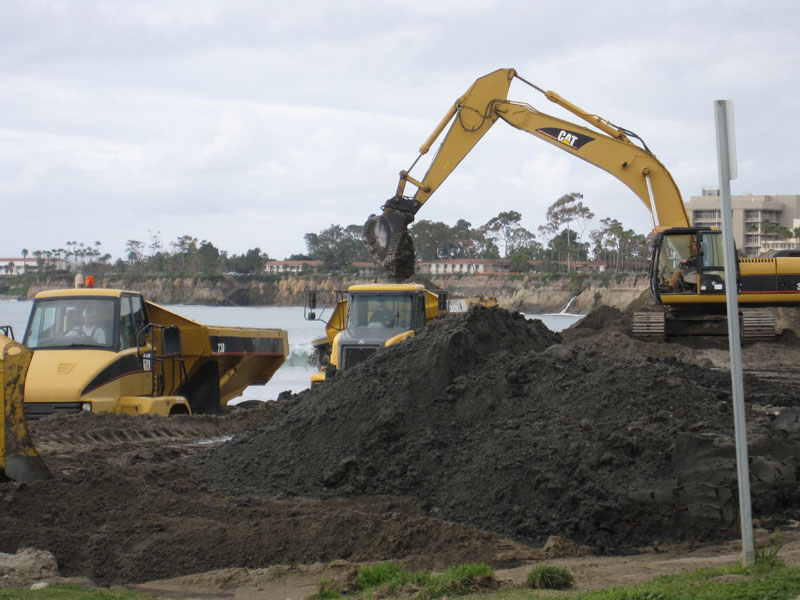
Beach-renourishement operations,California. Photograph: © SAF — Coastal Care.
“Development is absolutely responsible for the majority of the beach nourishment,” Andrew Coburn, assistant director of The Program for the Study of Developed Shorelines at Western Carolina University, said. “Well over 99 percent of the shorelines that are nourished are developed so there is some economic value placed behind them.”
Excerpts;
Beach replenishment is an expensive and temporary method of maintaining barrier-island beaches.
As the post-Hurricane Sandy rebuilding of all the beaches along New Jersey’s 127-mile Atlantic coast nears completion, an additional potential cost is becoming clear: Replenishment might be creating dead zones on land and at sea.
Read Full Article, Press of Atlantic City (02-03-2017)
The Beach Boondoggle; Op Ed by Robert Young, Director, PSDS; in The New York Times (10-12-2016)
Fishermen, beach builders fight for underwater sand hills; The Washington Times (01-14-2017)
The Jersey Shore’s Unquenchable Thirst for Sand; Philly (03-09-2015)
New Jersey, with its 127-mile coastline, has spent about $800 million on beach replenishment over the last 30 years – more than any other state, including Florida, which has an 1,800-mile coastline. That is equivalent to 80 million cubic yards of sand – or about a dump truck load for every foot of beach…
Coastal geologist criticizes beach renourishment efforts; By Robert S. Young, PhD; The State (08-17-2016)
Rob Young, who heads the Program for the Study of Developed Shorelines at Western Carolina University, said the government is subsidizing coastal development with renourishment money – and that’s costing taxpayers. Communities across the country have spent millions of dollars renourishing beaches. Those efforts encourage people to rebuild after every major hurricane…
The Barrier Islands: Islands in Motion; WFDD (08-03-2015)
For Vulnerable Barrier Islands, A Rush to Rebuild on U.S. Coast, Yale E 360 (01-18-2015)
Despite warnings from scientists, new construction continues on U.S. barrier islands that have been devastated by storms. The flood protection projects that accompany this development can have harmful consequences for coastal ecosystems being buffeted by climate change…
Coastal Barrier Resources System: Testimony of Robert S. Young, PhD (04-07-2014)
“The Beaches Are Moving,” A Video featuring Orrin Pilkey, PhD
World famous coastal geologist Orrin H. Pilkey takes us to the beach and explains why erosion has become a problem…
Palm Beach Mid-Town Dredge Project, A Youtube Video (02-04-2015)
“Beach nourishment projects like this have become commonplace along the US East and Gulf Coasts. These projects have immediate environmental impacts through burial of nearshore habitat and increased turbidity during project placement.The cumulative environmental impacts of doing this repeatedly on the same beach while conducting projects from Maine to Texas is unknown. But, we should be concerned. ” —Robert S. Young, PhD, Director, Program for the Study of Developed Shorelines, Professor, Coastal Geology, Western Carolina University
Beach replenishment may have far reaching impacts on ecosystems;” Phys.Org (03-29-2016)
UC San Diego biologists who examined the biological impact of replenishing eroded beaches with offshore sand found that such beach replenishment efforts could have long-term negative impacts on coastal ecosystems…
The Conservation Crisis No One Is Talking About, TakePart (09-21-2016)
Beaches around the world are disappearing. No, the cause isn’t sea-level rise, at least not this time. It’s a little-known but enormous industry called sand mining, which every year sucks up billions of tons of sand from beaches, ocean floors, and rivers to make everything from concrete to microchips to toothpaste…









